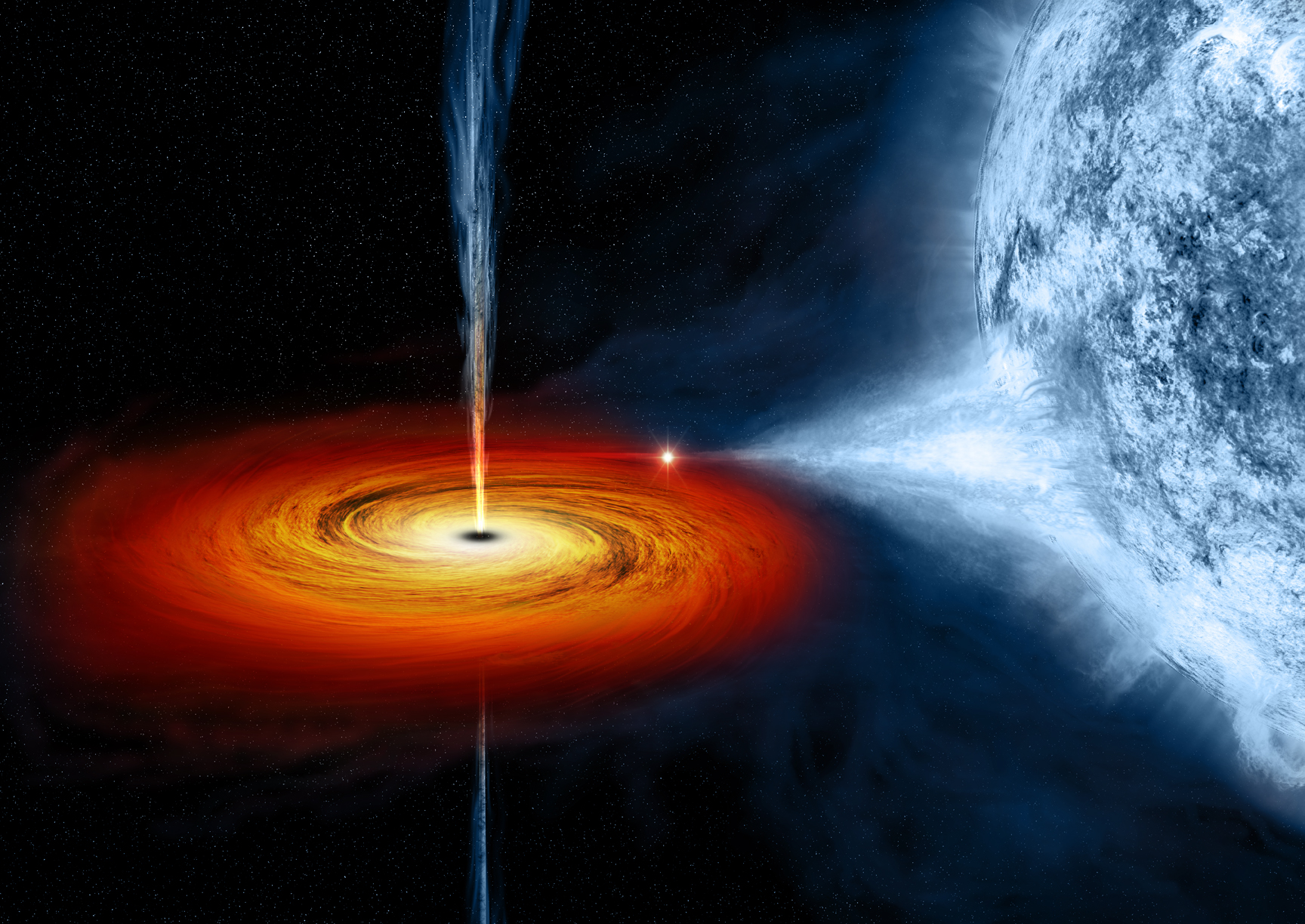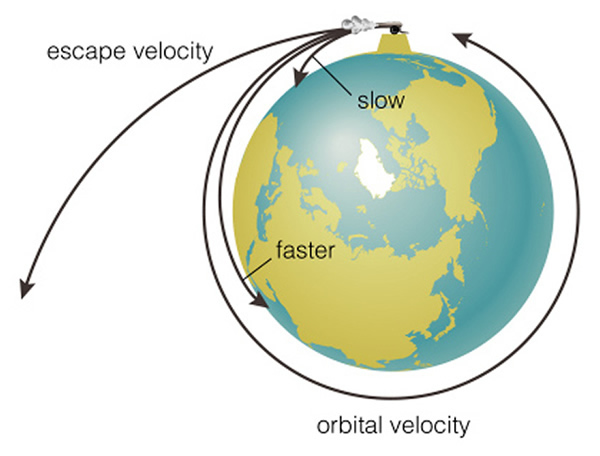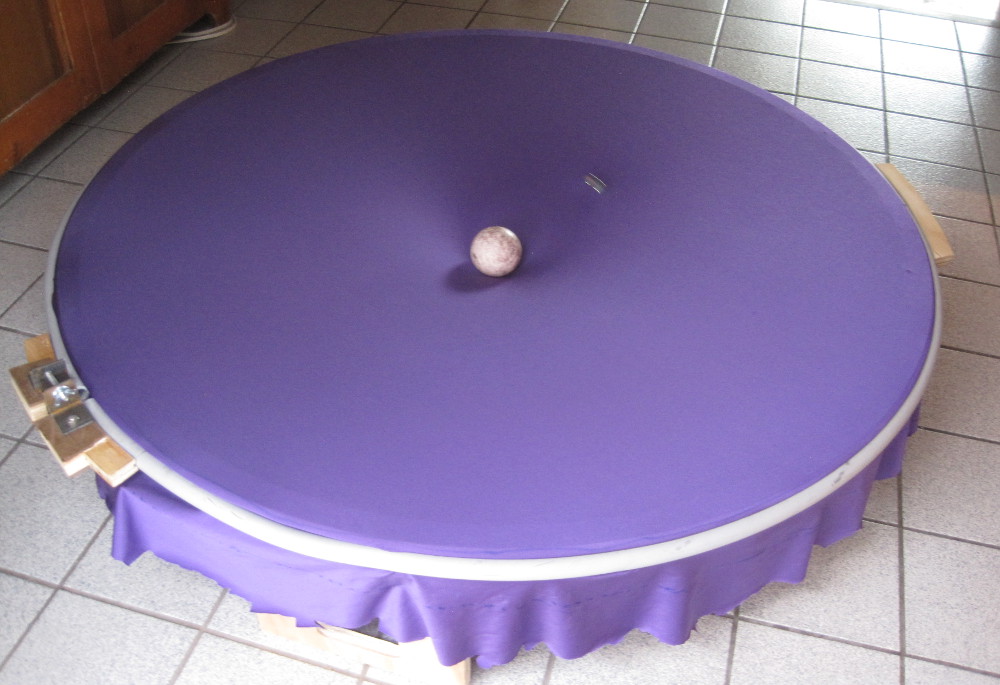 |
 |
|
Recently (2015) the movie
Interstellar came out. Some of the 6th-graders had seen it. For us
scientists, what is particularly interesting is that the depiction of
the black hole was accurate (as much as possible), guided by the advice and
calculations of physicist Kip Thorne.
|

|
| I started with the concept of
escape velocity. As shown
in the illustration, you can imagine shooting a cannonball faster and
faster, to the point where it would go round and round the earth
forever. Some kids were
a bit sceptical about this, but I pointed out that here in Santa Fe
(where the sky is almost always clear), they
can go outside after sunset and in a few minutes they can see a satellite
pass overhead, going around and around the earth just like that.
Any spaceship will be bound to the earth in some kind of orbit as long as
it's speed is less than 11 km/s (25000 mi/h). Above this
escape velocity, the spaceship will fly off into space and never return.
|

|
I did the standard
demonstration that shows how large masses distort space (actually,
spacetime)
and attract other
masses.
In 2018, I made this large hoop with
stretchy cloth.
This replaced the thing I used before, a large screen left over
from my silkscreening days.
A marble or 1/2' steel ball will roll in a straight line across
this surface without deviation, just as a spaceship, with the engines off
and not too close to a star or planet, will float through outer space in
a straight line. Of course our model is in 2 dimensions only. Now if
I put something heavy, like a smooth river rock, on the
cloth, it depresses the surface a fair bit in the middle,
flattening out again towards the edge of the frame. When the marble
is now placed on the screen, it will be attracted to the center. Also, if you
roll the marble on a trajectory close by the rock, its path will be
noticeably deflected. With some practice, you can even get your marble to
go into orbit around the river rock.
|

|
|
If you roll the marble slowly in the vicinity of the central rock, it will
roll back to the center. If you roll it too fast, it will escape. A black
hole is simply any object where the gravity is so strong that the escape
velocity is larger than the cosmic speed limit, the speed of light.
|
|
After the observation by LIGO of merging black holes in 2015, I was looking
for a way to build a mechanical demo. This is the result, and
here are the construction
and operation details.
| 
|
Here are some black hole links:
|
| Bring:
- Hoop
- Feet and motor
- Big extension cord
- Big rock
- Marbles etc
- Strobes
- Stepstool
|
1998, updated 2022
|

First, I wanted to show that
most of the electricity around us comes from 2 different sources: batteries
and generators.
For the batteries,
I did the standard stuff: any acid plus any two metals make a battery. I
had an orange, a lemon, and some scraps of cloth with vinegar. For
different metals, I had thick copper wire, big galvanized nails (for a
zinc surface), steel nails, aluminum foil, pennies. Then, with some
telephone wire and my old analog voltmeter, we made several batteries: the
standard one where you stick nails and wire of different metals into the
lemon or orange. We noted the different voltages, and hooked them up in
series to get a little higher. Unfortunately, one or two lemons is not
enough to light up a flashlight bulb. We made a 'Volta pile' (reference to
the original pile here) by stacking aluminum foil, vinegar-soaked cloth
and pennies.
For the generator part, I had made a simple generator:

- In a board, I screwed four 3" drywall screws in a 1.25x2"
rectangular pattern. Around this I wound a bunch of telephone wire.
- I had a pretty strong fridge magnet, about 2x1x3/8". I fixed an
axle to it by bending a piece of coathanger wire, and tying it
in place with string. The wire stuck out about 2" on either side.
- Two pieces of cardboard, folded, glued to the wood base, and with
slots in the top to hole the magnet, formed pretty good bearings.
- Slip the magnet into place, wrap masking tape around the axle right
next to the cardboard, so that the axle cannot slip sideways. The
masking tape also make a fatter place for your fingers to grab onto
when you twirl the magnet.
- Of course, the dimensions given here all depended on the particular
magnet you happen to have around. The goal is to have the wire as
close to the twirling magnet as possible, while at the same time
have enough clearance so that the magnet can twirl freely.
|
Twirling the magnet produces enough voltage to register easily on the
voltmeter (as AC, not DC, but I glossed over that detail), but again not
enough for a flashlight bulb. [Would an LED work?]
I realized that I did have a generator that
would light up a lamp. Being a Dutchman, I had in my box of bike parts an
ordinary 'dynamo', or bike generator. This thing mounts on the front
fork of your bike, and when engaged, presses against the tire.
Out of the same box came a front bike fork, and to complete the
demonstration, I borrowed a wheel from my garden cart, which I had built
using 2 front bicycle wheels. I could mount the whole assembly upside
down with some scraps of wood, and light up a bike light brightly with
even a gentle turn of the wheel.
In the real world, what turns generators?
We talked about dams, and generators powered by oil, gas, coal and nuclear
power. The children were clever enough to add solar and wind power to the
list. They were well aware of the fact that fossil fuels cause plenty of
environmental problems, but not that these fuels were going to run out in
their lifetimes, and that they had a big problem to solve when they grew
up to be engineers.
Links:
March 1998
|

Earlier in the year, we had looked at the sun with
the sunspotter
Time to talk about the sun and all that. Most of what I talked about is
on the first two web sites on the list below: How the sun is not as quiet
and peaceful as it may seem, that great blasts of material are blowing
away from the surface all the time, and that this solar wind roars by the
earth. How the Earth is like a big bar magnet that channels all that stuff
to the North and South poles. That the space shuttle typically flies lower
than the Aurora. One of the harder concepts (for these 3rd-graders) was
that the atmosphere does not just stop at a well-defined altitude, but
that there is (very) thin gas up where the shuttle flies, and higher still.
Check out the top 2 links below!
To show that the sun is not without blemishes, I also had brought
in my home-built sunspot viewer, and we took it outside and observed a fair
number (5 or so) sunspots that day. More on the sunspotter below.
|
 I brought a demo that showed the earth's magnetic field:
a bar magnet
rests under my screenprinting screen, white sheet on top, and a cutout of
the earth. Sprinkle iron filings around, and the shape of the magnetic
field appears.
I brought a demo that showed the earth's magnetic field:
a bar magnet
rests under my screenprinting screen, white sheet on top, and a cutout of
the earth. Sprinkle iron filings around, and the shape of the magnetic
field appears.
Bring:
- Screen and paper cover
- Magnets and iron filings
- Earth cutouts
- Compass
- Funnel, brush for cleanup
|
|
|
Here are some links to Northern and Southern lights:
1998...2017
|
|
|









